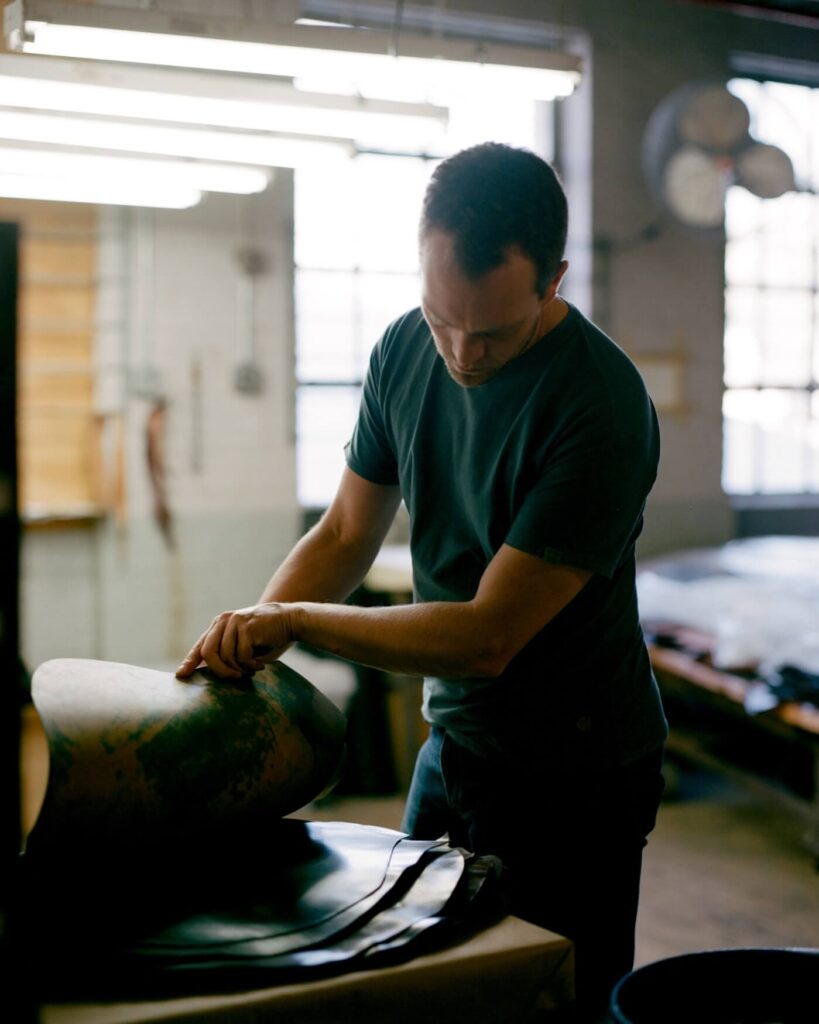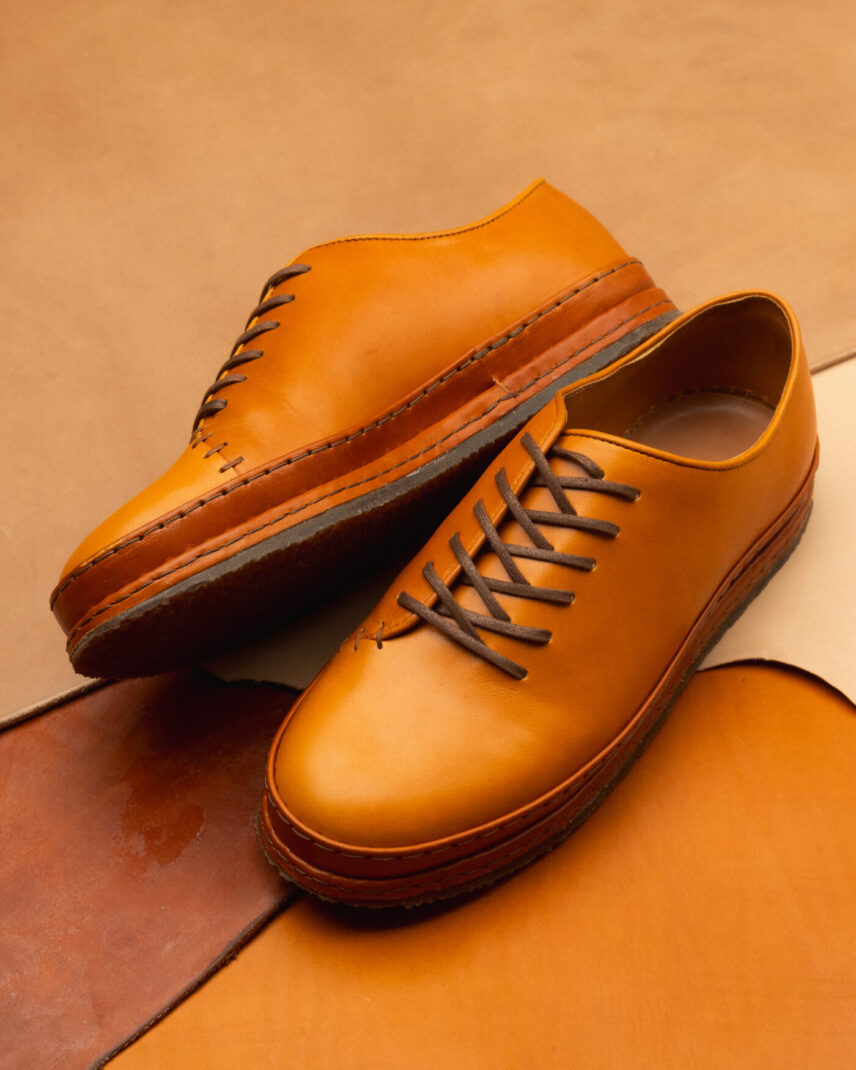This story originally appeared on the Gents Cafe Newsletter. You can subscribe here.
Crown Northampton is a quiet rebellion in the world of footwear. Founded in 1908 and reimagined through a made-to-order ethos, it bridges Northampton’s century-old shoemaking tradition with a modern belief in transparency, quality, and human connection.
In conversation with Managing Director Chris Woodford, we learn how small details—like the ring of a knife against a brass-bound pattern or the softness of kudu suede—echo a philosophy that values patience and precision. His story unfolds through family heritage, bold departures from mass production, and a vision of shoemaking as collaboration rather than routine manufacture.
In this Brand Talks interview, Chris shares why slowing down may be the most radical step forward in the craft of shoes.

Do you remember your earliest memory tied to the family business? Not as a professional—but as a child, a son, a quiet observer. What did it feel like back then?
My earliest memories are of wandering around my dad’s factories in Northampton. The business was founded in 1908 by my great-great-grandfather, and in the early days it was very much about bespoke shoemaking—ironically, closer to what I’m doing now. Over the years it went through many phases, and in the ’70s my dad moved to Northampton, where he mass-produced hand-stitched moccasins.
As a kid, I remember the scale of those big industrial factories: the drumming of the machinery, the smell of leather, the rattle of sewing machines, the clicking presses, the roughing machines. That whole sensory world stays with you. My dad used to tell me there was a mouse living under the floorboards in a little hole, and on Saturdays when I’d visit him, I’d spend hours running around the factory trying to find it. At the same time, I’d be playing with scraps of leather—cutting them into little shapes with blunt scissors. It was innocent fun, but also the start of me appreciating leather as a material.
What stuck with me was the divide between factory owners and the staff. I’ve always felt more on the side of the staff, so I’ve made an effort to close that gap.
Without even realizing it, I was learning. My dad would point out that you need to use the right leather for the right product, the right part of the shoe. Those lessons stick when you’re young. And I think that’s part of why I recreate that artisanal atmosphere today—because those early memories are when you’re most innocent and happiest.
I always knew I wanted to be involved in the industry, but having seen the struggles my family went through, I also knew I wanted more security than they had. Before the internet, so much depended on distributors. I remember one of my dad’s friends telling me he’d gone golfing with the head of the British Shoe Corporation, who owned 3,000 shops, and came back with an order for 300,000 pairs. That’s how things worked back then—deals sealed over a round of golf. To me, that never felt fair.
What also stuck with me was the divide between factory owners and the staff. I’ve always felt more like I’m on the side of the staff, so I’ve made a conscious effort to close that gap. That mindset has really shaped the way I run the business today.

What moment marked your official entry into the family business? Was there something you immediately wanted to shape in your own way?
I always knew I wanted to be in the industry, but I also knew I wanted to do it differently. I wanted control over what I was creating. By the time I left school—around 17—I already knew the academic path wasn’t for me. I was drawn to design, and I was pretty good at it, so it felt natural to head in that direction.
Back then, my dad’s business had gone from 300 employees down to just four or five. He was keeping things going, still producing for lots of different people, but I wanted to design my own pieces. To get there, I needed to learn. I went to college to study design and pattern cutting, but honestly, most of my real education came from the old craftsmen my dad employed.
I remember sitting with Jeff Schofield, who had worked for my father for years and was about 70 at the time, and I’d watch him pattern cut. He’d explain how to cut carefully so that, in mass production, the leather’s cutting coefficient worked out properly. I understood it all, but I also thought: I don’t want to think like that. Mass production didn’t feel viable anymore. Northampton had once been full of factories, but when I was starting out there were maybe 20 left—and today it’s down to six.
So I threw myself into learning both design and shoemaking, starting with traditional welted shoes, which Northampton is famous for. I respected the philosophy—using the best materials to make formal shoes—but if I’m honest, I wouldn’t wear them myself. At the same time, I was making all sorts of niche products to help keep my dad’s business alive: Formula One racing boots (we’re not far from Silverstone), boxing boots, bowling shoes. Small orders, odd projects—anything that would help.
The real turning point came when a Japanese buyer visited. He liked a style we were doing with a little crown logo and asked if we could make something for his market. That sparked an idea, and I designed a full range for Japan. This was about 20 years ago, and it became the start of the Crown brand. Suddenly we grew from five people to about a dozen, producing thousands of pairs a year for Japanese department stores.
It was exciting, but also stressful. I was designing my own shoes, but I was still dependent on distributors, buyers, and price points. I had some control, but not enough. That’s when I realised the only way to have full control was to design and sell directly to the customer. That way, whether we sold one pair or ten, we could run it through the factory without worrying about retail margins. It meant I could focus on making beautiful shoes with the best leathers, designed the way I wanted, and see if people connected with them.

How and when did you decide to start producing made-to-order shoes and handling distribution directly?
In the early days, I was making welted shoes for some stores on Savile Row. I remember looking at what I charged them versus what they were selling the shoes for—multiplying the price five times over—and realising just how much of a difference it would make if I sold directly rather than relying on distributors or simply acting as a manufacturer. That was the moment I knew I had to change the business model.
The shift didn’t happen overnight, but about five or six years later it really clicked: people were willing to buy shoes from a brand they’d never heard of, purely because they trusted the quality. That was a big surprise, and also a turning point. Moving to a made-to-order model completely changed the dynamic in the workshop. Our artisans aren’t producing a thousand identical pairs anymore—they’re making something for an individual person. Every order has the customer’s name on it, the shoes are hand-signed, and you can feel the care that goes into each pair. It’s no longer someone standing at a machine doing the same motion all day; it’s a craft with a purpose.
And it changes things for me, too. I get to speak directly with customers, learn what they want, and see how much they value the product. That interaction is what gives me the real buzz. Over time, I’ve realised it’s very much a Japanese way of working. In the West, you typically design a product backwards from a price: here’s what I want to make, here’s what it costs, here’s what I’ll sell it for. With us, it’s the opposite. I don’t know what something will cost until I’ve chosen the leathers, designed it, and actually made it. The product comes first, and the rest follows. It’s a far less restrictive way of working, and I love that freedom.
The other upside is loyalty. When I spend an hour fitting someone and understanding what they want, I know that customer is likely to stay with us for life. That time is always well invested.
How has this different business model changed the way you work, and what challenges did you have to face?
This business model has completely changed the way we work. The people here are genuinely valued now—before, they might have just felt like cogs in a machine. Their roles have become more flexible, more creative, and more collaborative. For example, the factory is open from four in the morning until six at night. As long as everyone completes their 39 hours a week, they can come and go as they like. If someone’s child has a sports day, they can go, enjoy it, and come back later. It doesn’t need to be rigid. That flexibility has created a much better working atmosphere.
Another big change was realising how much customer interaction comes with selling directly online. When I started, I didn’t imagine we’d need a customer care team—but now we’ve got four people handling emails, answering questions about sizing, fit, high arches, insteps, leathers, and custom requests. The answer to most things is “yes,” but it requires a different way of working. In many ways, I’m trying to recreate what my great-great-grandfather offered: a shop where someone could walk in, order a shoe to their exact specifications, and have it made for them. The difference is, we’re doing it globally and online.
And when we design something new, it goes straight through the factory. The people here have as much say in the design as I do. Rather than a team of machinists, I’ve got a team of collaborators. That shift has been massive. It means we can create something truly unique without worrying about what the rest of the world is doing. I’ve always believed that if you’re spending too much time looking at competitors, it’s probably because you’re not doing enough yourself.

“Every Order – Made To Order”. What does that change — both for the business and for the person receiving the product?
It changes the relationship on both sides. For the customer, it becomes a far more considered purchase. They’re not just clicking “buy now” and hoping the size works; they engage with us, ask questions, and make sure they’re choosing the right product. That process already makes the shoe feel more personal.
For us as a business, the difference is huge. Our return rate is around 3%, compared to the 20% or more that’s common in online retail. In the traditional model, people often order three pairs, keep the one that fits, and send the others back—leaving the brand with slightly worn shoes it can’t sell as new. That cost gets baked into the price. By contrast, our low return rate means we can put more money into higher-quality materials from the start, without having to inflate prices to cover waste.
There’s also the human element. Because each shoe is made for a specific individual, our craftsmen approach the work differently. Every order is a different size, leather, or fitting, and needs to be hand-lasted to the customer’s specifications. That takes time, but it’s what makes the product unique. Materials like cork and vegetable-tanned leather need to sit and settle on the last—it can’t be rushed. If a pair of shoes came out of here in two days, I’d be worried. The waiting time is part of the craft.
It becomes a far more considered purchase: they’re not just clicking “buy now” and hoping the size works; they engage with us, ask questions, and make sure they’re choosing the right product.
What’s been unexpected is how often the relationship grows beyond a single order. Once customers get the fit right, they’ll come back and ask for a matching belt, or commission something more personal. Over time, it feels less like a transaction and more like an ongoing collaboration.
Of course, not everyone wants to wait 9 to 12 weeks. Many people will always prefer to pick something off a shelf. But we only need a few thousand people a year who value this approach, to prove that it works. In fact, in a country where many manufacturers are shrinking, we’re growing—and I think that shows there’s a real appetite for a slower, more considered way of buying shoes.

Is there a moment in the process — a sound, a smell, a step — that feels strangely satisfying every time?
There are quite a few little moments like that. Just this morning, for example, I picked up a knife and it made that perfect ringing noise as the blades touched the leather—such a clean, satisfying sound. When I’m hand-cutting, especially for our most intricate shoes, I still use old brass-bound patterns. As the clicking knife moves around the edge, it makes that distinctive “click” when it hits the brass. That sound has been the same for generations, and it never gets old.
Then there are the materials themselves. The feel of kudu suede, for instance, is something really special—soft, rich, unlike anything else. Or oak bark calf leather: knowing it’s spent a year in pits of water, that it’s taken three years to dry and twenty years for the oak tree to grow, makes it extraordinary before you even cut it. When you look closely, you see little marks left by the oak bark as it sat against the hide—tiny details that carry the story of how it was made.
Cordovan is another one—it’s tricky to work with because of the different thicknesses, but when you hold it, especially in lighter colours, the way it catches the light is just beautiful.
5. If you had to tell the story of Crown Northampton through three iconic pieces, which would you choose and why?
The first piece would be the Overstone sneaker. It was the very first design I created for Crown Northampton, and it set the tone for our minimal, considered approach. Everything about it was local—from the boxes and dust bags to the lasts and shoe trees, all made within minutes of Northampton. It was also about proving that you could make a truly premium sneaker, using the best calf leather, while keeping it as minimal as possible—every stitch and cut of leather serving a purpose.
Next would be the Cordovan Harlestone from our hand-stitched collection. With this shoe, I set aside price considerations and designed purely from heritage and craft. Using materials like cordovan, oak bark, cork, and vegetable-tanned linings, it became a cross between a sneaker and a dress shoe—something that carried our family history. It was born during COVID, when machinists were working from home, so the hand-stitch details were as much a necessity as they were a nod to tradition. That period of adversity shaped the design, and the response from customers was incredibly validating.
Finally, the Ernest sneaker, our most recent creation. This model feels like the culmination of everything—my family history in shoemaking, Northampton’s tradition, down to my great-great-grandfather establishing his shoemaking business. We went the extra mile: handmade boxes lined in the same leather as the shoes, locally-made dust bags, and even video documentation of each pair being made. Customers can scan a QR code to watch their shoe take shape, sometimes even with their own music playing in the workshop. It turns the process into something personal, something more than just buying a shoe.

You’ve said that “the best things from our past should help us step into the future.” How do you decide what’s worth carrying forward and what to leave behind?
For me, it’s about balance. You can’t live only in the past, but you also can’t ignore it—heritage has to evolve. My design approach is unintentionally minimal, which means everything we carry forward has to serve a purpose, not just tradition for tradition’s sake.
Take the hand-welted sneaker, for example. It came about after someone challenged me to make “the best sneaker in the world.” To me, that meant it had to include Northampton’s shoemaking heritage. We used traditional welting techniques but adapted them into something new: two welts stitched in different directions, combining centuries-old skills with a modern sneaker silhouette. That innovation came directly from conversations with my team, experimenting and pushing what we could do while staying true to our roots.
Heritage is everywhere in what we do—the tannery we source leather from has been operating for 500 years, and Northampton itself was built on shoemaking. But the goal isn’t to copy the past; it’s to honor it in a way that feels relevant today. If one of our shoes were to sit in Northampton’s shoe museum, I’d want it to represent both where we’ve come from and where we’re going.
Has working slowly taught you anything about how to live better?
It has definitely changed the way I live. It forces me to stop rushing and really consider what I’m doing, instead of just reacting in the moment. Everything today feels instant—designs that disappear from your feed in seconds, decisions made in a heartbeat. But for me, designing or choosing materials can take months. I’ve had leather sitting on a shelf for half a year before I knew what it was meant to become. That slower process naturally makes you more thoughtful.
It’s not just about work—it shapes my life, too. I live in a little stone cottage I renovated with my wife, twenty minutes from the factory. That kind of hands-on approach feels important. I often think about how many old Northampton factories have been turned into flats, and how incredible it would be if they were revived as places where people make things again.
Once you start living and working this way, it’s hard to go back. You can’t easily say, “Let’s do it cheaper, let’s cut corners.” There’s always a market for that, but it’s not the world I want to be part of.

Is there a book, film, journey or place that has particularly inspired your life, or the direction you’ve taken with the brand?
I’ve just come back from Italy with my family, and it was beautiful. I can already feel how that trip will influence the way I design the next thing. I don’t really sit down with a sketchbook—I’m not that kind of designer. For me, it’s always about working directly with a last, with the leather, and seeing how I can use those materials in a way that feels right. There are always piles of leather around me, sparking ideas for the next project.
Books have also shaped me, especially French satirical writers. They remind me not to take life too seriously, but to take other people’s lives seriously—and I think that balance is important. At the end of the day, I know I’m just making shoes; I’m not saving lives. But I am giving people careers, and that matters. That’s fulfilling in a very real way.
What I want people to understand most is how much we care—about the work, the craft, and the people. We’re not just making shoes, we’re trying to quietly change how people shop, to get them asking more questions and valuing the story behind what they buy. And when that happens, a factory job becomes something more: a career people are proud of.









